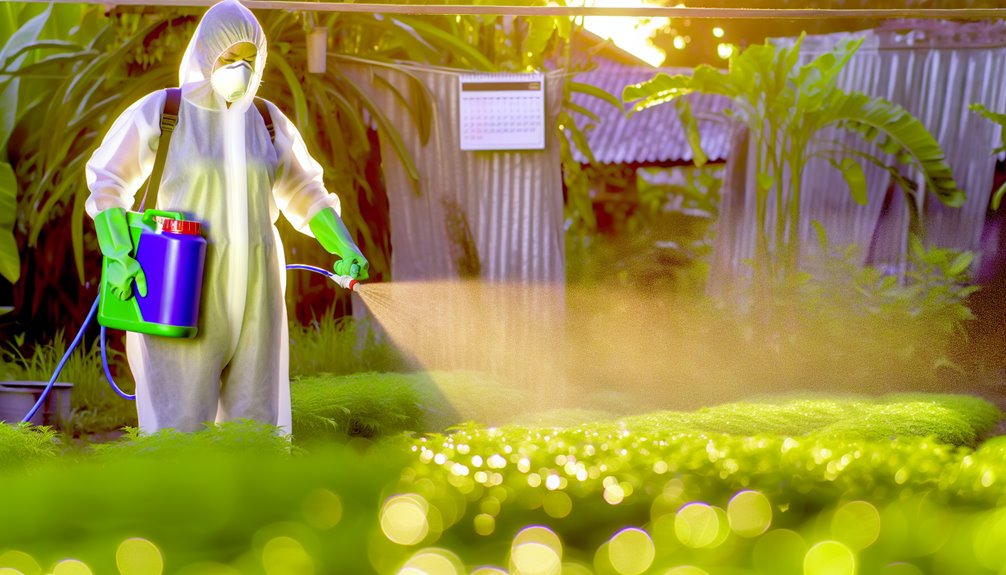You probably don’t know that barrier sprays can cut mosquito landing rates by 80–95% while larvicides reduce adult emergence by up to 90% at sources. Used together, they target resting adults and aquatic stages, closing the coverage gap single methods leave. You’ll see fewer bites within 24–48 hours and sustained suppression over weeks, if you time applications to breeding cycles and surface persistence—but the timing, products, and intervals you choose determine whether that promise holds.
Understanding Barrier Sprays: How They Create a Protective Perimeter

Although the term sounds simple, a barrier spray is a residual insecticide application that binds to foliage, fences, and eaves to create a kill-and-repel zone around your property. You deploy a calibrated spray application to target shaded vegetation where adult mosquitoes rest. Studies show residuals can reduce landing rates 70–90% for several weeks, depending on formulation, surface type, and weather. For perimeter protection, you’ll map edges, treat underside leaf surfaces, and avoid blooms to protect pollinators. You’ll schedule reapplications based on rainfall and pressure data. By focusing on adult vectors’ resting sites, you create measurable, service-oriented outcomes: fewer bites, safer gatherings.
Larvicides Explained: Interrupting the Mosquito Life Cycle at the Source
Before adult mosquitoes ever bite, larvicides target their aquatic stages—egg, larva, and pupa—to collapse populations at breeding sites. You assess mosquito habitats—gutters, birdbaths, tire ruts, rain barrels—and apply products where water holds for 7–30 days. Evidence shows precise placement reduces emergence by 80–95% when monitored weekly.
Use larvicide ingredients matched to site conditions:
1) Bti/Bs israelensis: bacteria that disrupt larval gut receptors; low non-target risk.
2) Methoprene: growth regulator preventing pupae from becoming adults; long residual.
3) Oils/films: smothering agents effective in polluted water.
You verify efficacy with dip counts, document rainfall, and schedule reapplications to sustain suppression while respecting community needs.
Why Synergy Matters: Closing Gaps Single Methods Leave Behind

Even with diligent larviciding, surveillance data routinely shows residual adult activity from cryptic breeding sites, storm-driven influxes, and migratory mosquitoes—gaps a barrier spray can close. You serve communities best when you pair tools that produce synergistic effects. Field trials demonstrate that adding residual barrier applications to larval source management reduces human landing rates 40–70% beyond either method alone. You intercept vectors at two stages: deny emergence and suppress surviving or incoming adults resting in vegetation. That integrated pest control approach lowers biting pressure, infection risk, and complaint volumes, while buffering against resistance by diversifying modes of action and exposure windows.
Step-by-Step Plan to Combine Treatments for Maximum Coverage
Once surveillance confirms target species, seasonality, and hotspots, sequence actions to cover both life stages efficiently. Map coverage zones by vegetation density, container counts, and human-use patterns. Build a treatment schedule aligned to degree-days and rainfall forecasts. Deploy larvicides first in all aquatic habitats, then apply barrier sprays to perimeter and harborage foliage to intercept adult vectors returning to rest.
- Quantify: use dip counts, ovitrap indices, and adult landing rates to set thresholds.
- Prioritize: target zones exceeding thresholds; escalate frequency after rain spikes.
- Verify: re-sample at 48–72 hours; adjust nozzle selection, droplet size, and re-entry intervals to sustain suppression and service outcomes.
Safety, Timing, and Maintenance Tips for Long-Lasting Results

Although barrier sprays and larvicides target different life stages, you’ll extend control and reduce risk by timing applications to meteorology and adhering to label-driven safety margins. Calibrate equipment, verify droplet spectra, and apply with low wind (<10 mph), moderate humidity, and stable temperatures for ideal deposition. Use PPE, mix precisely, and protect pollinator habitat by avoiding blooms. Sequence larvicides 24–48 hours before barrier treatments to suppress emergence waves. Integrate seasonal considerations: increase inspection frequency after rainfall and during peak vector periods. Standardize application techniques, rotate actives by mode-of-action, and document intervals. Reassess hotspots biweekly, refresh residues post-storms, and communicate findings with stakeholders.
Conclusion
As the owner of Mosquito Eliminators of South MS, I understand how important it is to keep your outdoor spaces enjoyable and free from pesky mosquitoes. By combining barrier sprays with effective larvicides, we can ensure that your property remains a hard target against these unwelcome guests. I encourage you to take the next step towards reclaiming your yard—visit us at mosquitoeliminatorsms.com or give us a call at (601) 336-2277. Together, we can create a comfortable outdoor environment for you and your loved ones. Let’s make your backyard the perfect place to relax and enjoy!

